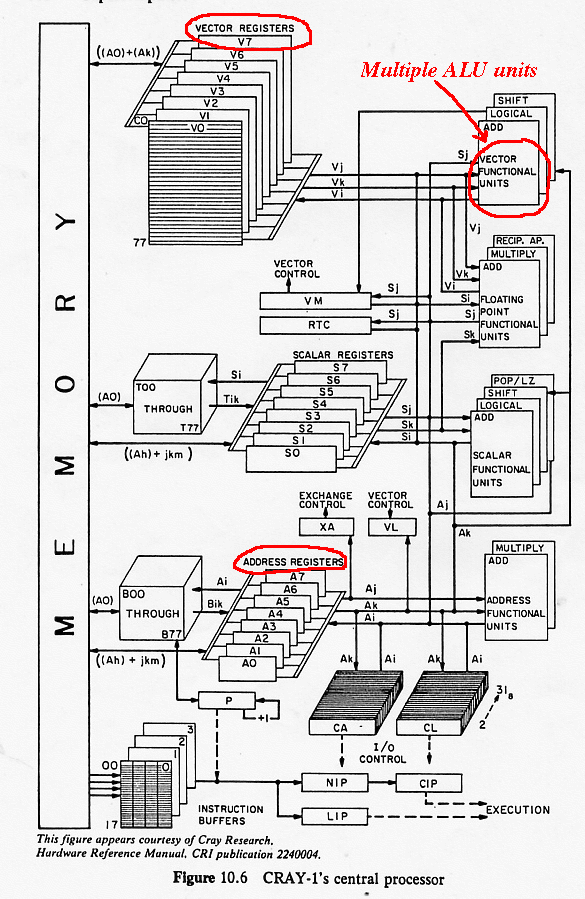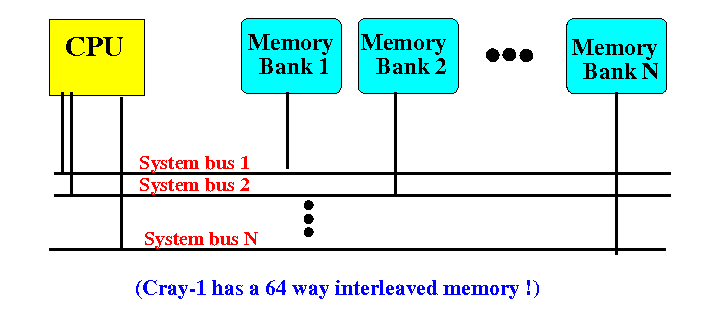- Computer programs can be:
- Compute bound - bottleneck in executing the program is the CPU
- IO bound - bottleneck in executing the program are the I/O operations
- Many programs that are compute bound, are often
numerical analysis applications
- such as "weather prediction", "nuclear reactor simulation", etc.
- These problems often use
vector
and/or
matrix operations
- A vector is just an
array
of numerical values, e.g.:
+- -+ | 1 | v = | 1 | | 1 | +- -+ - A matrix is a
two-dimensional arry
of numerical values, e.g.:
+- -+ | 1 0 0 | A = | 1 0 0 | | 1 0 0 | +- -+
- In many operations involving vectors and matrices,
the same operation
is performed on
many (different) rows or columns
- Example 1: Vector Addition
+- -+ +- -+ +- -+ | 1 | | 5 | | 6 | | 2 | + | 4 | = | 7 | | 3 | | 1 | | 4 | +- -+ +- -+ +- -+(The elements are added row-wise)
(The addition operation is applied to all rows)
- Example 2: Matrix Multiplication
- Each row of matrix A
is multiple with
each column of matrix B
- The operations performed are
the same
(multiple and then add):
SAME instructions
But each row of matrix A uses DIFFERENT operands (data)
+- -+ |A11 A12 A13| A = |A21 A22 A23| |A31 A32 A33| +- -++- -+ |B11 B12 B13| B = |B21 B22 B23| |B31 B32 B33| +- -+Then:
+- -+ |C11 C12 C13| C = A*B = |C21 C22 C23| |C31 C32 C33| +- -+ where: Cij = Ai1*B1j + Ai2*B2j + Ai3*B3j (for i = 1, 2, 3 and j = 1, 2, 3) - Each row of matrix A
is multiple with
each column of matrix B
- To give you a better idea what is involved
in performing instructions in
parallel,
we will consider in some details a
parallel
Matrix-matrix Multiplication
- Suppose we want to multiply the following 2 matrices:

- We will go through the steps in the
parallel
Matrix-matrix Multiplication
While going through the example, make a note that the same operations are performed on each column.
Initialization step (done once):

Processing Row 1:
-
Step 1: multiply and add on multiple operands

-
Step 2: multiply and add on multiple operands

-
Step 3: multiply and add on multiple operands

Processing Row 2:
-
Step 1: multiply and add on multiple operands

And so on....
- SIMD computers are the first type of parallel computers specially designed to perform
- SIMD computers are also known as
vector computers
- because they provide a special set of machine instructions
that operate on vectors.
- SIMD computers also have special
vector registers
that the
vector instructions
operate on.
- Here is a schematic of the Cray 1 vector processor (CPU):

- Notice the Cray-1 has
multiple addresses registers
The Cray has multiple system busses:

- The Cray it can send out
multiple memory requests with different
addresses
So it can fetch multiple operands from memory at the same time - But ONLY IF the operands are stored in DIFFERENT memory banks
- Example:
To perform this step in the matrix multiplication:

It must
-
Fetch all 7 operands (circled)
-
in parallel
- Then perform these
multiply operations
( also in parallel ):
- 2 x 3
- 2 x 6
- 2 x 2
- Then perform these 3
addition operations
( also in parallel ):
- 0 + (2 x 3)
- 0 + (2 x 6)
- 0 + (2 x 2)
-
Fetch all 7 operands (circled)
-
in parallel
- The Vector Functional Units has multiple ALU units that can perform multiple operations (on different values) simultaneously - under the control on the (same one) vector instruction
- The era of SIMD Vector processor as in the past.
- Today, the most commonly used parallel computers are MIMD - built with "cheap" (relative) Intel CPU.